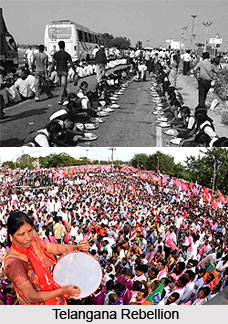 Telangana Rebellion which was formally known as Vetti Chakiri Udyamam Bonded Labour Movement or Telangana Raithanga Sayudha Poratam Telanana Peasants Armed Struggle was a peasant rebellion against the feudal lords of the Telangana region and later against the rulers of Princely State of Hyderabad between 1946 and 1951.
Telangana Rebellion which was formally known as Vetti Chakiri Udyamam Bonded Labour Movement or Telangana Raithanga Sayudha Poratam Telanana Peasants Armed Struggle was a peasant rebellion against the feudal lords of the Telangana region and later against the rulers of Princely State of Hyderabad between 1946 and 1951.
Telangana Rebellion was headed by the Communists of India started in the year 1946, just after the Independence of India. Telangana Rebellion was started against the oppressive feudal lords of Princely State of Hyderabad. Later this armed peasant rebellion quickly spread to the Warangal district of Telangana and Bidar district in around 4000 villages.
The peasant farmers and labourers revolted against the local jagirdars and deshmukhs of Hyderabad, who were ruling the villages known as "samsthans". These "samsthans" were ruled mostly by the ruling classes in Hyderabad, Reddy and Velama. They were locally known as "doralu". They ruled over the communities of Telangana in the village and managed the tax collections and owned almost all the land in that area. The Nizam had little control over these regions, barring the capital Hyderabad. Chakali Ilamma, belonging to a Rajaka caste, had revolted against the local feudal landlord Ramachandra Reddy. During the civil strife, when he tried to take Chakali Ilamma`s four acres of land. Her revolt inspired many to join the Telangana Revolt.
The agitation led by Communists was successful in liberating over 3000 villages from the feudal lords and 10,000 acres of agricultural land was distributed to landless peasants. Around 4000 peasants lost their lives in the struggle fighting feudal mercenaries.
Later, Telangana movement got its momentum when it had gone against the Nizams of Hyderabad. The initial modest aims were to do away with the illegal and extreme exploitation meted out by these feudal lords in the name of bonded labour. The most vociferous demand was for the writing off of all debts of the peasants that were manipulated by the feudal lords.
With the decline of administration of Hyderabad after 1945, the Nizam succumbed to the pressure of the Muslim elites and started the Razzakar Movement, which was very violent and was also responsible for forcible conversions of religion. At the same time the Nizam was resisting the efforts of Government of India to bring the Hyderabad state into the Indian Union. The government sent the army in September 1948 to capture the Hyderabad state into Indian Union. The Communist party had already instigated the peasants to use guerrilla tactics against the Razzakars and around 3000 villages had come under peasant rule. The landlords were either killed or driven out and the land was redistributed. The rebellion of Telangana was led by the Communist Party of India under the banner of Andhra Mahasabha.
Among the well-known persons at the forefront of the Telangana movement were Ravi Narayana Reddy, Puchalapalli Sundarayya, Pillaipalli Papireddy, Suddala Hanmanthu, Chandra Rajeswara Rao, Bommagani Dharma Bhiksham, Makhdoom Mohiuddin, Sulaiman Areeb, Hassan Nasir, Manthrala Adi Reddy, Bhimreddy Narasimha Reddy, Mallu Venkata Narasimha Reddy and Mallu Swarajyam.
The violent phase of Telangana movement ended in 1951, when the last guerrilla squads were subdued in the Telengana region.
Telangana movement certified the victory of the struggled peasants and the Communist Party in Andhra Pradesh. In 1952 elections in Andhra Pradesh, Communist Party of Andhra Pradesh became victorious and the new land reforms, which were peasant friendly, were recognised as important and various acts were passed to implement them.



















